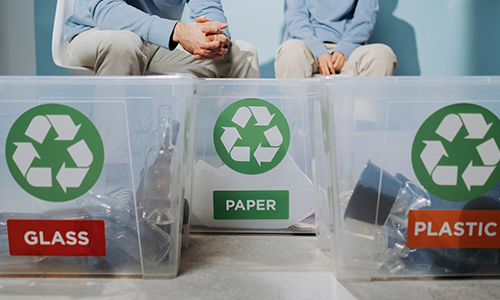Glove Intelligent Assistant
09.12.2023

Across the entire Ask GIA Blog, we’ve discussed the topic of sustainability and waste disposal hierarchies. It is an integral component of any manufacturing process with any commercial product. If our manufacturing practices are unsustainable, our business is unsustainable. This includes waste, and our waste economy. A waste economy comprises the system of a product’s lifecycle – starting when resources are mined or sourced, made into products, and then when they become waste.
Our company is focused on employing a circular waste economy. We are working to reduce the unnecessary use of raw materials and to recapture our waste byproduct as a means to manufacture new raw materials or products. While it is preferred to work on waste prevention and limit waste generation (topics we have discussed in previous articles), there still remains waste to be disposed of on a macro industrial level. Waste generation does not just pertain to the glove industry, as many other commercial industries are attempting to shift towards more sustainable waste economies. This week’s article will dive deeper into sustainable waste disposal choices.
The most prevalent methods of waste disposal today are incineration, the usage of landfills, or recycling. Incineration is the method of waste disposal by burning waste at around 1500 to 2000 degrees Celsius in a furnace designed with a combustion chamber. The amount of time it takes depends on the amount of waste and the size of the chamber. Large rocks and debris must be taken out before the incineration process as well. The process can take between weeks to years, eventually converting the waste to various gasses and ash. An advantage is that the collected gasses can be turned into fuel.
Medical gloves that are contaminated with bodily fluids or other potentially infectious materials are considered regulated medical waste in many healthcare settings. The disposal of such waste is subject to strict regulations and guidelines to ensure the safety of healthcare workers, patients, and the environment. While incineration is one method of disposal for certain types of medical waste, it may not be the only option, and the specific disposal method can vary depending on local regulations and the nature of the waste.

Landfills often have a negative association as many people associate them with open dumping. However, modern landfills are federally regulated. They are not allowed to be built in environmentally vulnerable areas and have on site environmental monitoring systems. There are also different types of landfills, the most common being municipal landfills for everyday waste. There are separate landfills for hazardous waste and industrial waste.
The waste is then allowed to decompose naturally. Many facilities collect the methane gas and repurpose it into energy. The average time for waste to completely decompose back into organic material can be decades depending on the material. However, the advantage is that there is no additional energy or financial cost incurred by this disposal process. When landfills are full they are closed and covered in soil to prevent soil erosion.
Lastly, there is recycling or the process of recovering raw materials and reusing them to make new products. There are 4 major groups waste is divided into for the recycling process: metal, plastic, paper, and glass. It requires labor to sort and separate the waste into appropriate categories. Particularly for plastic, there are subcategories of plastic recycling like: physical, chemical, and plastic pyrolysis recycling.

Physical plastic recycling involves melting the plastic into new products. Chemical recycling is the process of reverting the plastic back into a monomer with the possibility of reverting it to a virgin plastic polymer. Plastic pyrolysis is the process of converting plastic into petroleum fuel. The recycling process involves specialized facilities and additional energy costs.
While these methods are popular, they are not without their own disadvantages. Recycling has long been touted around as the best method of sustainable waste disposal, there is a caveat when it comes to recycling plastic. Plastic polymers are very hard to break down so it would require supplementing great amounts of energy and water to do so. Only limited special facilities can process them as well. The extra shipping, processing and handling costs do not contribute to a lesser impact to the environment as perceived by the general public.
Furthermore, recycling plastics has a limited lifecycle, as reusing plastic polymers shortens its polymer chain and weakens it. While it may seem chemical recycling would solve this complication, it is actually an additional demerit. Chemical recycling releases toxic chemicals into the environment and should not be considered as a viable form of recycling plastics.
Nitrile gloves are indeed challenging to recycle compared to some other materials due to their composition and the limited recycling infrastructure for them. Nitrile gloves are made from a synthetic rubber called nitrile, which is not as readily recyclable as some other materials like paper, plastic, or aluminum. While there are some specialized recycling programs and companies that can handle nitrile gloves, they typically require a more complex and energy-intensive recycling process compared to simpler materials. These processes may not be widely available or cost-effective.
As for landfills, there is an obvious disadvantage. More than half our waste is dumped in landfills and we are running out of space. Beyond the issue of space is the production of methane gasses and the potential of waste leakage into groundwater. It is the slowest method of waste disposal too. Yet the faster method of waste disposal, incineration, has its own drawbacks. Burning waste can emit toxic gasses and additional greenhouse gasses.
Furthermore, the ashes from the waste must still be disposed of in landfills. In conclusion, there is no perfect sustainable way in disposing of plastic waste. We must continue to push for creating high quality durable products with long lifecycles and avoid the creation of preventable waste.
Uncontaminated nitrile gloves can typically be disposed of in a landfill. The exact time it takes for a traditional nitrile glove to degrade in a landfill can vary depending on environmental conditions, such as temperature, moisture levels, and microbial activity within the landfill. However, it is generally estimated that nitrile gloves can persist in a landfill for several decades to over a century, and in some cases, they may not degrade significantly at all.